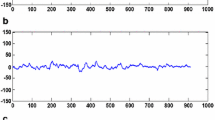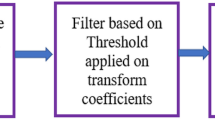Abstract
Electroencephalography (EEG) is widely utilized non-invasive method for studying cerebral activities emanating within brain cortex of the order of microvolts. One of the major problems encountered during visual EEG analysis is the presence of artifacts arising from the subject. Ocular artifact (OA) is one of the major sources of unavoidable artifacts that are of high magnitude, thereby making information retrieval a troublesome task. The work discusses the different methodology to be followed for OA identification. This paper implements and compares various statistical and time warping distance techniques which are mostly used for estimating feature distance as well as clustering application for identification of ocular artifacts. Apart from this, the paper proposes a robust adaptive thresholding technique for precise identification of ocular epochs. Along with precision and adaptive characteristics, computational time is also considered as significant factor in the study. The experimental results exhibited a notable performance of 98.4% and 91.68% at an optimal threshold for kurtosis and Dynamic time warping (DTW) respectively but both did not give consistent results for varying datasets (in terms of adaptive and computational time). However, proposed adaptive thresholding technique gave noteworthy results in identifying single, bidirectional as well as multiple ocular peaks surpassing both kurtosis and DTW in all terms.










Similar content being viewed by others
References
Islam, M. K., Rastegarnia, A., & Yang, Z. (2016). Methods for artifact detection and removal from scalp EEG: A review. Clinical Neurophysiology,46, 287–305.
Bisht, A., Kaur, C., & Singh, P. (2018). Recent advances in artifact removal techniques for EEG signal processing. Intelligent Communication, Control and Devices,989, 385–392. https://doi.org/10.1007/978-981-13-8618-3.
Jung, C. Y., & Saikiran, S. S. (2016). A review on EEG artifacts and its different removal technique. Asia-Pacific Journal of Convergent Research Interchange,2(4), 43–60.
Patel, R., Janawadkar, M. P. R., Sengottuvel, S., & Gireesan, K. (2016). Suppression of eye-blink associated artifact using single channel EEG data by combining cross-correlation with empirical mode decomposition. IEEE Sensors Journal,16(18), 6647–6654.
Roy, V., & Shukla, S. H. (2019). Designing efficient blind source separation methods for EEG motion artifact removal based on statistical evaluation. Wireless Personal Communications,108, 1311–1327.
Vescio, B., Salsone, M., Gambardella, A., & Quattrone, A. (2018). Comparison between electrocardiographic and earlobe pulse photoplethysmographic detection for evaluating heart rate variability in healthy subjects in short- and long-term recordings. Sensors,18(3), 844–857.
Hasnat, A., Halder, S., Bhattacharjee, D., & Nasipuri, M. (2013). Comparative study of distance metrics for finding skin color similarity of two color facial images. In National conference on advancement of computing in engineering research (ACER) (pp. 99–108). https://doi.org/10.5121/csit.2013.3210.
Garg, N., Ryait, H. S., Kumar, A., & Bisht, A. (2017). An effective method to identify various factors for denoising wrist pulse signal using wavelet denoising algorithm. BioMedical Materials and Engineering,29(1), 53–65.
Holt, G. A., Reinders, M. J. T., & Hendriks, E. A. (2007). Multi-dimensional dynamic time warping for gesture recognition. In 13th annual conference of the advanced school for computing and imaging (p. 300).
Wang, J., Zhu, Y., Li, S., & Wan, D. (2014). Multivariate time series similarity searching. The Scientific World Journal. https://doi.org/10.1155/2014/851017.
Ertuğrul, Ö. F. (2019). A novel distance metric based on differential evolution. Arabian Journal of Science and Engineering. https://doi.org/10.1007/s13369-019-04003-5.
Tappert, C. C., Suen, C. Y., & Wakahara, T. (1990). The state of the art in on-line handwriting recognition. IEEE Transaction on Pattern Analysis and Machine Intelligence,12(8), 787–808.
Bankó, Z., & Abonyi, J. (2012). Correlation based dynamic time warping of multivariate time series. Expert System with Application,39, 12814–12823.
Kuzmanic, A., & Zanchi, V. (2007). Hand shape classification using DTW and LCSS as similarity measures for vision-based gesture recognition system. In IEEE international conference on computer as a tool (EUROCON) (pp. 264–269).
Cheng, Z. C., Lin, C. S., & Chen, Y. H. (2011). Fast music information retrieval using pat tree based dynamic time warping. In IEEE 8th international conference on information, communications and signal processing, (ICICS) (pp. 1–5).
Akila, A., & Chandra, E. (2013). Slope finder—A distance measure for DTW based isolated word speech recognition. International Journal of Engineering and Computer Science,2(12), 3411–3417.
Thakkar, B., & Vyas, A. L. (2009). Outlier pulse detection and feature extraction for wrist pulse analysis. In International conference on biological science and technologies (ICBST) (pp. 173–176).
Magdy, A. K., Khadragi, A., Saeb, M., & Mohamed, A. B. (2013). Analysis of DNA signal representation applying dynamic time warping (DTW) and derivative dynamic time warping (DDTW). The International Journal of Computer Science and Communications Security (IJCSCS),3, 61–70.
Bisht, A., Garg, N., Ryait, H. S., & Kumar, A. (2016). Comparative analysis of DTW based outlier segregation algorithms for wrist pulse analysis. Indian Journal of Science and Technology,9(47), 1–5.
Myers, C., Rabiner, L., & Rosenberg, A. (1980). Performance tradeoffs in dynamic time warping algorithms for isolated word recognition. IEEE Transactions on Acoustics, Speech, and Signal Processing,28(6), 623–635.
Garg, N., Bisht, A., Ryait, H. S., & Kumar, A. (2018). Identification of motion outliers in wrist pulse signal. Computers & Electrical Engineering,67, 1–15.
Shaw, L., Routray, A., & Sanchay, S. (2017). A robust motifs based artifacts removal technique from EEG. Biomedical Physics & Engineering Express,3(3), 1–18.
Greco, A., Mammone, N., Morabito, F. C., & Versaci, M. (2008). Kurtosis, Renyi’s entropy and independent component scalp maps for the automatic artifact rejection from EEG data. World Academy of Science, Engineering and Technology,2(9), 344–348.
Anuragi, A., & Sisodia, D. S. (2019). Alcohol use disorder detection using EEG Signal features and flexible analytical wavelet transform. Biomedical Signal Processing and Control,52, 384–393.
Ikeda, S., Ishii, R., Pascual-Marqui, R. D., Canuet, L., Yoshimura, M., Nishida, K., et al. (2019). Automated source estimation of scalp EEG epileptic activity using eLORETA Kurtosis analysis. Neuropsychobiology,77(2), 1–9.
Jeong, Y., Jeong, M., & Omitaomu, O. (2011). Weighted dynamic time warping for time series classification. Pattern Recognition,44, 2231–2240.
Keogh, E. J., & Pazzani, M. J. (2001). Derivative dynamic time warping. In First SIAM international conference on data mining (SDM), 2001.
Delorme, A., Sejnowski, T., & Makeig, S. (2007). Enhanced detection of artifacts in EEG data using higher-order statistics and independent component analysis. NeuroImage,34(4), 1443–1449.
Khatun, S., Mahajan, R., & Morshed, B. I. (2016). Comparative analysis of wavelet based approaches for reliable removal of ocular artifacts from single channel EEG. IEEE Journal of Translational Engineering in Health and Medicine,4, 1–8.
Zhao, Q., Hu, B., Shi, Y., Li, Y., Moore, P., Sun, M., et al. (2014). Automatic identification and removal of ocular artifacts in EEG—Improved adaptive predictor filtering for portable applications. IEEE Transactions on Nanobioscience,13(2), 109–117.
Sweeney, K. T., McLoone, S. F., & Ward, T. E. (2013). The use of ensemble empirical mode decomposition with canonical correlation analysis as a novel artifact removal technique. IEEE Transactions on Biomedical Engineering,60(1), 97–105.
Chavez, M., Grosselin, F., Bussalb, A., Fallani, F. D. V., & Navarro-Sune, X. (2018). Surrogate-based artifact removal from single-channel EEG. IEEE Transactions on Neural Systems and Rehabilitation Engineering,26(3), 540–550.
Islam, M. K., Rastegarni, A., & Yang, Z. (2016). A wavelet-based artifact reduction from scalp EEG for epileptic seizure detection. IEEE Journal of Biomedical and Health Informatics,20(5), 1321–1332.
Arqub, O. A., AL-Smadi, M., Momani, S., & Hayat, T. (2016). Numerical solutions of fuzzy differential equations using reproducing kernel Hilbert space method. Soft Computing,20, 3283–3302.
Arqub, O. A., AL-Smadi, M., Momani, S., & Hayat, T. (2017). Application of reproducing kernel algorithm for solving second-order, two-point fuzzy boundary value problems. Soft Computing,21, 7191–7206.
Arqub, O. A. (2017). Adaptation of reproducing kernel algorithm for solving fuzzy Fredholm–Volterra integrodifferential equations. Neural Computing and Applications,28, 1591–1610.
Arqub, O. A., & Abo-Hammour, Z. (2014). Numerical solution of systems of second-order boundary value problems using continuous genetic algorithm. Information Sciences,279, 396–415.
Yeung, N., Bogacz, R., Holroyd, C. B., & Nieuwenhuis, S. (2007). Theta phase resetting and the error-related negativity. Psychophysiology,44(1), 39–49.
Shoeb, A. X., Edwards, H., Connolly, J., Bourgeois, B., Treves, S. T., & Guttag, J. (2004). Patient-specific seizure onset detection. Epilepsy & Behavior,5(4), 483–498.
Parvez, M. Z., & Paul, M. (2015). Epileptic seizure detection by exploiting temporal correlation of electroencephalogram signal. IET Signal Processing,9(6), 467–475.
Acknowledgements
This research work is supported by Technical Education Quality Improvement Project III (TEQIP-III) of MHRD, Government of India assisted by World Bank under Grant Number P154523 and sanctioned by UIET, Panjab University, Chandigarh (India).
Author information
Authors and Affiliations
Corresponding author
Ethics declarations
Conflict of interest
The authors declare that there is no conflict of interest regarding the publication of this paper.
Additional information
Publisher's Note
Springer Nature remains neutral with regard to jurisdictional claims in published maps and institutional affiliations.
Rights and permissions
About this article
Cite this article
Bisht, A., Singh, P. Identification of Single and Multiple Ocular Peaks in EEG Signal Using Adaptive Thresholding Technique. Wireless Pers Commun 113, 799–819 (2020). https://doi.org/10.1007/s11277-020-07253-x
Published:
Issue Date:
DOI: https://doi.org/10.1007/s11277-020-07253-x




